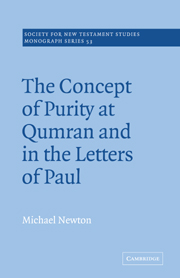Book contents
- Frontmatter
- Contents
- Acknowledgements
- List of abbreviations
- 1 Introduction
- 2 The concept of purity in the Qumran community
- 3 Purity and the cult in the letters of Paul
- 4 Purity and membership of the Church
- 5 Purity and the continuing life of the Church
- 6 Conclusion
- Notes
- Bibliography
- Index of passages cited
- General index
4 - Purity and membership of the Church
Published online by Cambridge University Press: 10 December 2009
- Frontmatter
- Contents
- Acknowledgements
- List of abbreviations
- 1 Introduction
- 2 The concept of purity in the Qumran community
- 3 Purity and the cult in the letters of Paul
- 4 Purity and membership of the Church
- 5 Purity and the continuing life of the Church
- 6 Conclusion
- Notes
- Bibliography
- Index of passages cited
- General index
Summary
Introduction
Having established that Paul teaches that the Church is the Temple of God and as such is ministered to in a priestly fashion by its members, as well as having brought to it offerings in the form of converts who offer themselves as living sacrifices, we need now to return directly to an examination of Paul's use of the concept of purity, a concept essentially connected to Temple life, the priesthood, and the sacrificial system.
As we noted above, the Temple or, more specifically, the sanctuary within the Temple, was acknowledged as the place where God had his special dwelling. The continued presence of the divine within the Holy of Holies could only be guaranteed by keeping the sanctuary and its precincts pure. Thus the Jerusalem Temple was separated from the outside world and protected from the impurity that abounded around it. Only Jews could enter its inner portals and only priests, in a state of purity, ‘charged with assuring the purity of the sanctuary’, could minister in its inner precincts. The sacrifices themselves were directed towards maintaining the divine presence and ‘most cultic activity was motivated, directly or indirectly by this objective, especially the process of ritual expiation … most particularly the blood rites designated by the verb kipper’. Furthermore all sacrifices that were to be offered on its altars had also to come up to a high standard of purity.
- Type
- Chapter
- Information
- Publisher: Cambridge University PressPrint publication year: 1985



